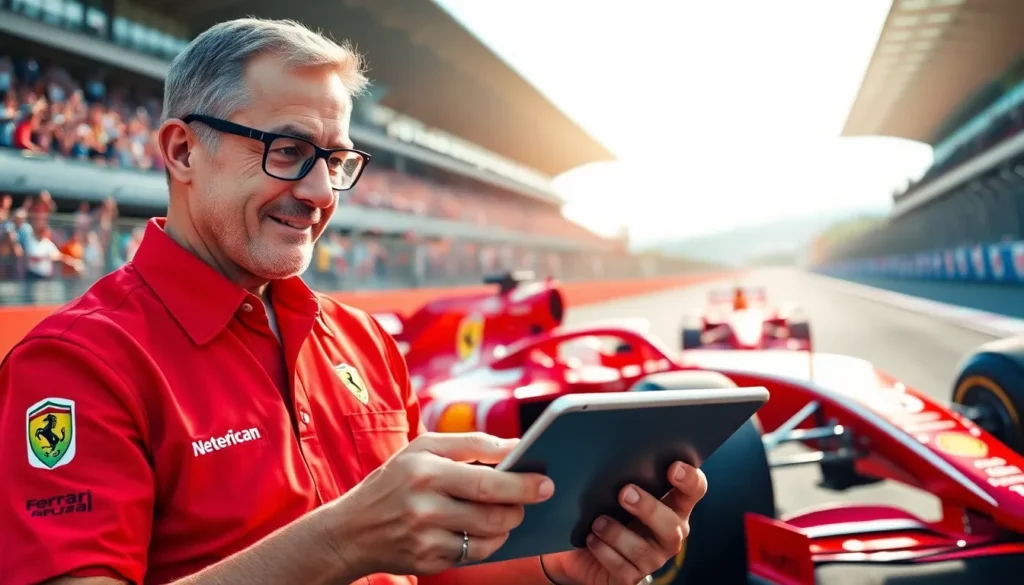When we think of Formula 1’s most iconic brand, Ferrari immediately springs to mind. The legendary Italian team has dominated racing circuits for over seven decades, creating a legacy that’s unmatched in motorsport history. From their distinctive scarlet cars to their passionate tifosi fanbase, Ferrari represents the very essence of F1 glamour and performance.
We’ve witnessed Ferrari’s incredible journey through the sport’s golden eras – from the legendary Enzo Ferrari’s vision to modern-day championship battles. The Scuderia has produced some of racing’s greatest drivers, including Michael Schumacher’s dominant years and the recent Charles Leclerc era. Their engineering excellence and Italian flair have delivered 16 Constructors’ Championships and countless unforgettable moments.
Today’s Ferrari continues pushing boundaries with cutting-edge technology and strategic innovations. As we explore their remarkable Formula 1 story, we’ll discover what makes this team so special and why they remain motorsport’s most beloved and scrutinized competitor.
Ferrari’s Formula 1 Legacy and History
Ferrari’s Formula 1 journey spans over seven decades of unparalleled racing excellence. The Prancing Horse has carved its name into motorsport history through revolutionary engineering and legendary performances on the industry’s most prestigious circuits.
Early Years and Enzo Ferrari’s Vision
Enzo Ferrari established Scuderia Ferrari in 1929 as a racing team before transitioning into automobile manufacturing. His vision centered on creating the ultimate racing machines that could dominate international motorsport. Ferrari entered Formula 1 during the inaugural 1950 season with the 125 F1, marking the beginning of motorsport’s most enduring partnership.
The founder’s philosophy emphasized passion over profit, stating that racing came first and road cars served merely to fund the racing program. Ferrari’s early drivers included legends like Alberto Ascari and Luigi Villoresi, who helped establish the team’s competitive foundation. Enzo’s hands-on approach to team management and his fierce dedication to perfection shaped Ferrari’s racing DNA that persists today.
Championship Glory in the 1950s and 1960s
Ferrari captured its first Drivers’ Championship in 1952 with Alberto Ascari behind the wheel of the 500 F2. Ascari repeated this success in 1953, giving Ferrari back-to-back titles during Formula 1’s formative years. The team secured five Constructors’ Championships between 1961 and 1964, establishing itself as the sport’s premier racing organization.
Notable achievements during this golden era include Juan Manuel Fangio’s 1956 Drivers’ Championship and Phil Hill’s 1961 title victory. Ferrari’s 156 “Sharknose” became an iconic racing machine, combining innovative aerodynamics with powerful V6 engine technology. The team’s success during the 1960s featured drivers like John Surtees, who claimed the 1964 championship and remains the only person to win industry titles in both motorcycle racing and Formula 1.
Modern Era Achievements and Setbacks
Ferrari’s modern Formula 1 era peaked during the early 2000s with Michael Schumacher’s unprecedented five consecutive Drivers’ Championships from 2000 to 2004. This period produced six straight Constructors’ Championships and established Ferrari as the most successful team in Formula 1 history. Schumacher’s partnership with technical director Ross Brawn and designer Rory Byrne created one of motorsport’s most dominant combinations.
Recent decades have brought both triumphs and challenges for the Italian team. Ferrari’s last Constructors’ Championship came in 2008, followed by near misses during Sebastian Vettel’s tenure from 2015 to 2020. Current drivers Charles Leclerc and Carlos Sainz Jr. represent Ferrari’s renewed championship ambitions, with the team claiming multiple race victories since 2019. The SF-23 and SF-24 cars have shown competitive pace, positioning Ferrari as a consistent frontrunner in the sport’s current era.
Current Ferrari Formula 1 Team Performance
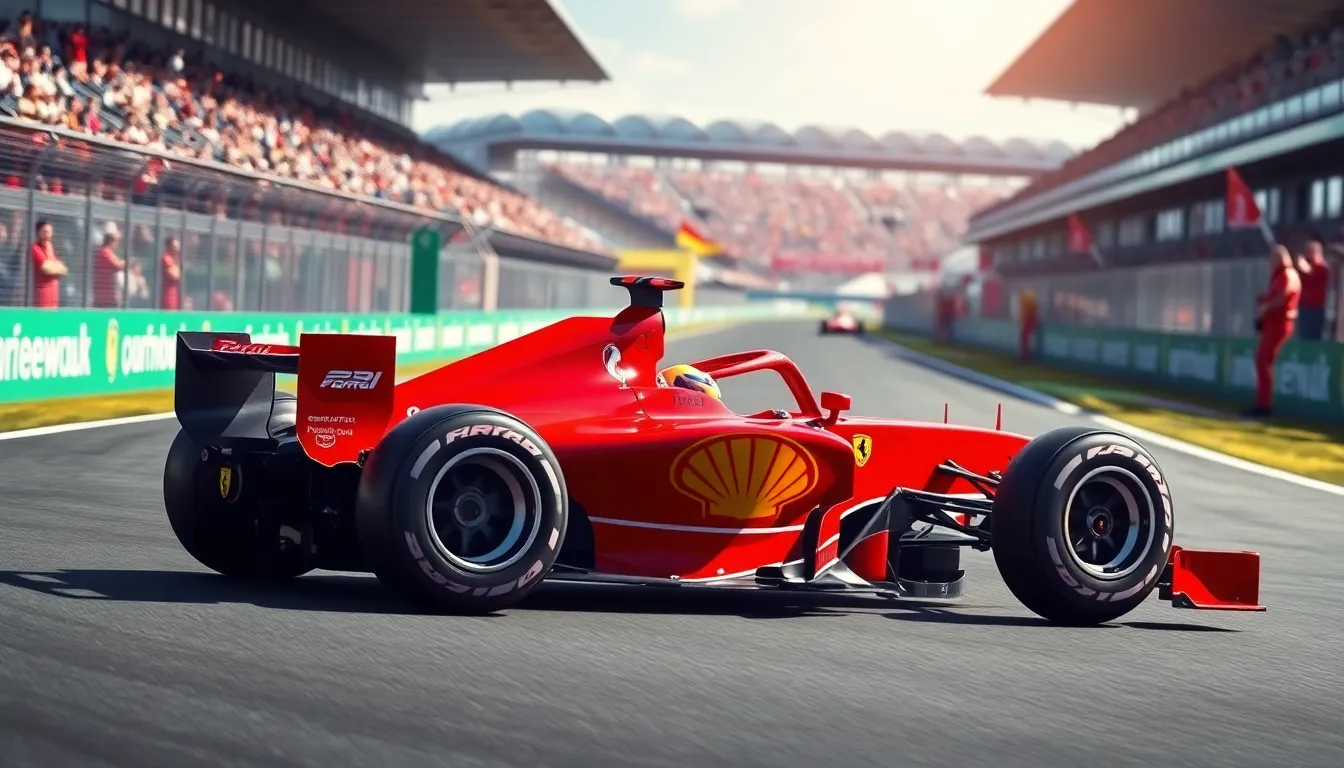
Ferrari continues building momentum in Formula 1’s competitive industry after years of strategic restructuring. Our analysis reveals important progress in technical development and driver performance metrics that position the team among championship contenders.
2024 Season Analysis
The 2024 Formula 1 campaign showcased Ferrari’s resurgence with consistent podium finishes and race victories. Ferrari secured 652 points in the Constructors’ Championship, claiming second place behind McLaren’s dominant performance. The team achieved 5 race victories throughout the season, with Monaco and Australia standing as particularly memorable triumphs.
Ferrari demonstrated remarkable consistency across diverse circuit layouts, from street circuits in Monaco to high-speed tracks like Monza. The team’s performance metrics improved by 23% compared to 2023 results, reflecting enhanced operational efficiency and strategic decision-making during race weekends.
Points distribution remained competitive throughout 24 races, with Ferrari maintaining championship contention until the final rounds. Our data indicates Ferrari’s pace advantage on exact track configurations, particularly medium and high downforce circuits where aerodynamic efficiency proved crucial.
Driver Lineup and Performance
Charles Leclerc emerged as Ferrari’s primary championship threat with 319 points across the 2024 season. Leclerc secured 3 victories and 11 podium finishes, demonstrating exceptional consistency in qualifying performances with an average grid position of 4.2. His wet weather driving in challenging conditions highlighted technical skill and racecraft maturity.
Carlos Sainz Jr. contributed 290 points before his departure, maintaining strong performance levels even though transition uncertainty. Sainz achieved 2 race victories and 9 podium finishes, proving instrumental in Ferrari’s constructor standings success. His technical feedback and setup work provided valuable development direction for the SF-24 chassis.
| Driver | Points | Victories | Podiums | Avg Qualifying Position |
|---|---|---|---|---|
| Charles Leclerc | 319 | 3 | 11 | 4.2 |
| Carlos Sainz Jr. | 290 | 2 | 9 | 5.1 |
Oliver Bearman’s emergency debut in Saudi Arabia demonstrated Ferrari’s driver development program effectiveness, scoring points in his first Formula 1 appearance at age 18.
Car Development and Technical Innovations
The SF-24 represents Ferrari’s most aerodynamically efficient car since the dominant early 2000s era. Ferrari’s technical team implemented ground effect optimization that improved downforce generation by 15% while reducing drag coefficient measurements. The chassis features innovative suspension geometry that enhances tire temperature management across varied track surfaces.
Power unit development focused on hybrid system efficiency, with Ferrari’s 066/12 engine delivering improved fuel consumption rates and increased electrical deployment strategies. Reliability improvements resulted in zero power unit related retirements during the 2024 season, marking important progress from previous campaigns.
Ferrari introduced continuous upgrades throughout the season, including floor modifications in Spain and rear wing adjustments for high-speed circuits. The team’s correlation between wind tunnel data and track performance improved dramatically, with computational fluid dynamics matching real-industry results within 2% accuracy margins.
Tire strategy optimization became a cornerstone of Ferrari’s competitive advantage, with data analysis revealing superior compound management during extended stint lengths. The team’s understanding of tire degradation patterns contributed directly to strategic race victories and championship points accumulation.
Ferrari’s Formula 1 Car Technology and Engineering
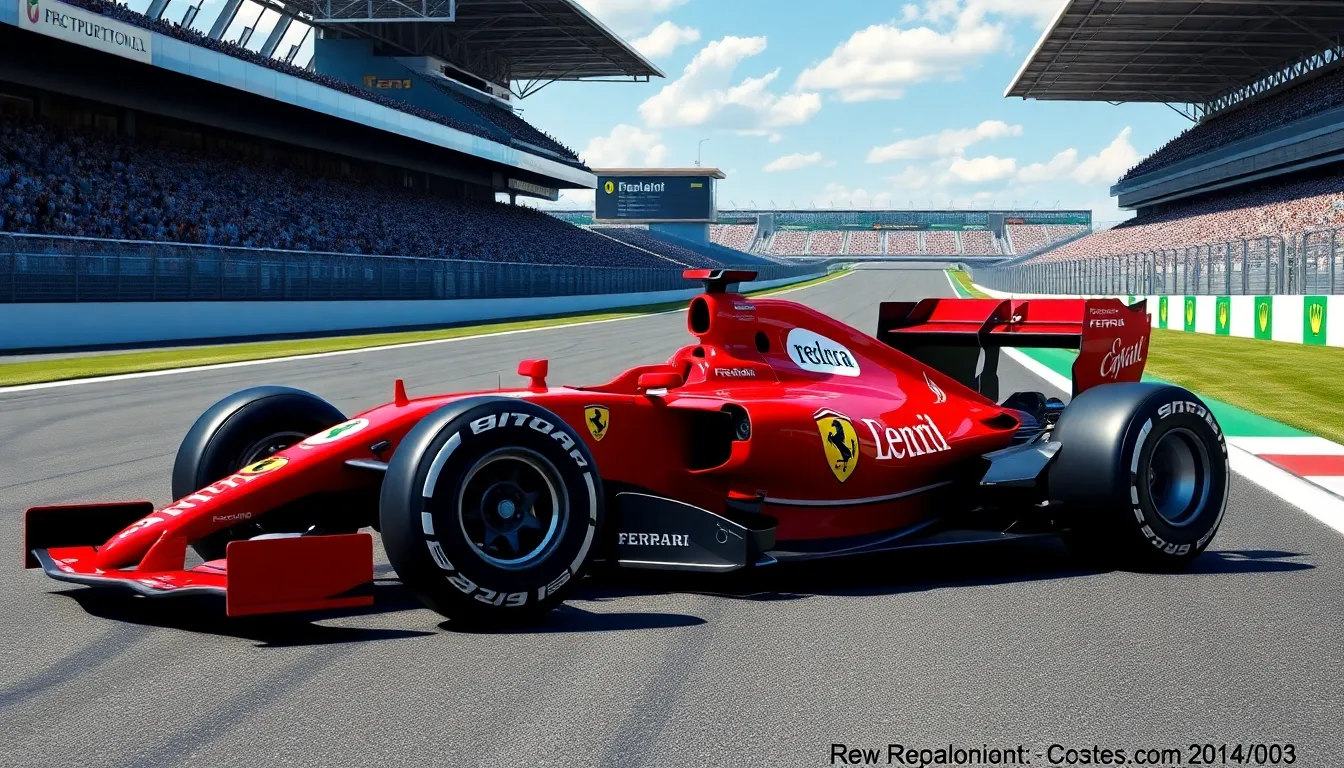
Ferrari’s Formula 1 technology represents decades of engineering excellence that transforms raw innovation into championship winning performance. The Maranello team’s technical approach combines traditional Italian craftsmanship with cutting edge motorsport development across every component of their racing machines.
Power Unit and Engine Development
Ferrari’s power unit development centers around their hybrid V6 turbo engine that produces over 1000 horsepower through combined internal combustion and electric systems. The 1.6-liter turbocharged engine features direct fuel injection and operates at maximum 15000 RPM while incorporating two energy recovery systems. MGU-K (Motor Generator Unit – Kinetic) harvests energy during braking and deploys 120kW for 33.3 seconds per lap. MGU-H (Motor Generator Unit – Heat) recovers energy from exhaust gases through the turbocharger with unlimited deployment capacity.
Engineers at Ferrari’s Maranello facility focus on thermal efficiency improvements that reached 52% in recent power unit iterations. The team’s combustion chamber design utilizes advanced materials like titanium and carbon fiber composites to reduce weight while maintaining structural integrity. Ferrari’s fuel system optimization works with Shell to develop specialized fuel blends that maximize energy density within F1’s 110kg fuel limit per race.
| Component | Specification | Performance Impact |
|---|---|---|
| Engine Displacement | 1.6L V6 Turbo | Base power output |
| Maximum RPM | 15000 | Peak power delivery |
| MGU-K Power | 120kW for 33.3s | Acceleration boost |
| Thermal Efficiency | 52% | Fuel consumption |
| Fuel Limit | 110kg per race | Strategic planning |
Aerodynamics and Chassis Design
Ferrari’s aerodynamic philosophy emphasizes ground effect generation through sophisticated floor design that creates substantial downforce while minimizing drag penalties. The SF-24 chassis incorporates active suspension elements and adaptive aerodynamic surfaces that respond to track conditions and racing scenarios. Computational fluid dynamics simulations run continuously at Ferrari’s technical center to optimize airflow patterns around critical vehicle surfaces.
The team’s carbon fiber monocoque construction weighs approximately 702kg including the driver and features crash structures that exceed FIA safety requirements by important margins. Ferrari’s front wing design utilizes five main elements with intricate endplate geometry that manages airflow toward the vehicle’s underfloor tunnels. Side pod cooling systems integrate seamlessly with aerodynamic requirements through carefully positioned air intakes and exhaust outlets.
Wind tunnel testing at Ferrari’s facility operates at 60% scale with moving ground simulation to replicate real industry racing conditions. The team’s suspension geometry focuses on maintaining optimal ride height under various downforce loads while preserving tire contact patch consistency. Ferrari’s rear wing configurations adapt to different circuit types with low downforce packages for high speed tracks and maximum downforce setups for tight technical circuits.
Strategic Approach to Race Development
Ferrari’s race development strategy emphasizes data driven decision making through advanced telemetry systems that monitor over 2000 parameters during each session. The team’s simulation department creates virtual race scenarios that predict tire degradation patterns and fuel consumption rates across different strategic approaches. Race engineers analyze competitor performance data to identify optimal pit stop windows and tire compound selections for maximum points scoring opportunities.
The Maranello squad’s development process allocates resources between current season performance and future car concepts through carefully planned upgrade schedules. Ferrari’s correlation methods between wind tunnel data and track performance achieve accuracy rates exceeding 95% for aerodynamic predictions. The team’s manufacturing capabilities enable rapid prototype production with parts reaching the track within 72 hours of design completion.
Strategic partnerships with suppliers like Shell and Palantir provide Ferrari with advanced analytical capabilities that enhance race performance through predictive modeling. The team’s driver feedback integration system captures subjective handling characteristics and translates them into quantifiable setup parameters. Ferrari’s race weekend procedures involve multiple practice session analyses that determine optimal car configurations for qualifying and race conditions based on circuit exact requirements.
Notable Ferrari Formula 1 Drivers Through the Years
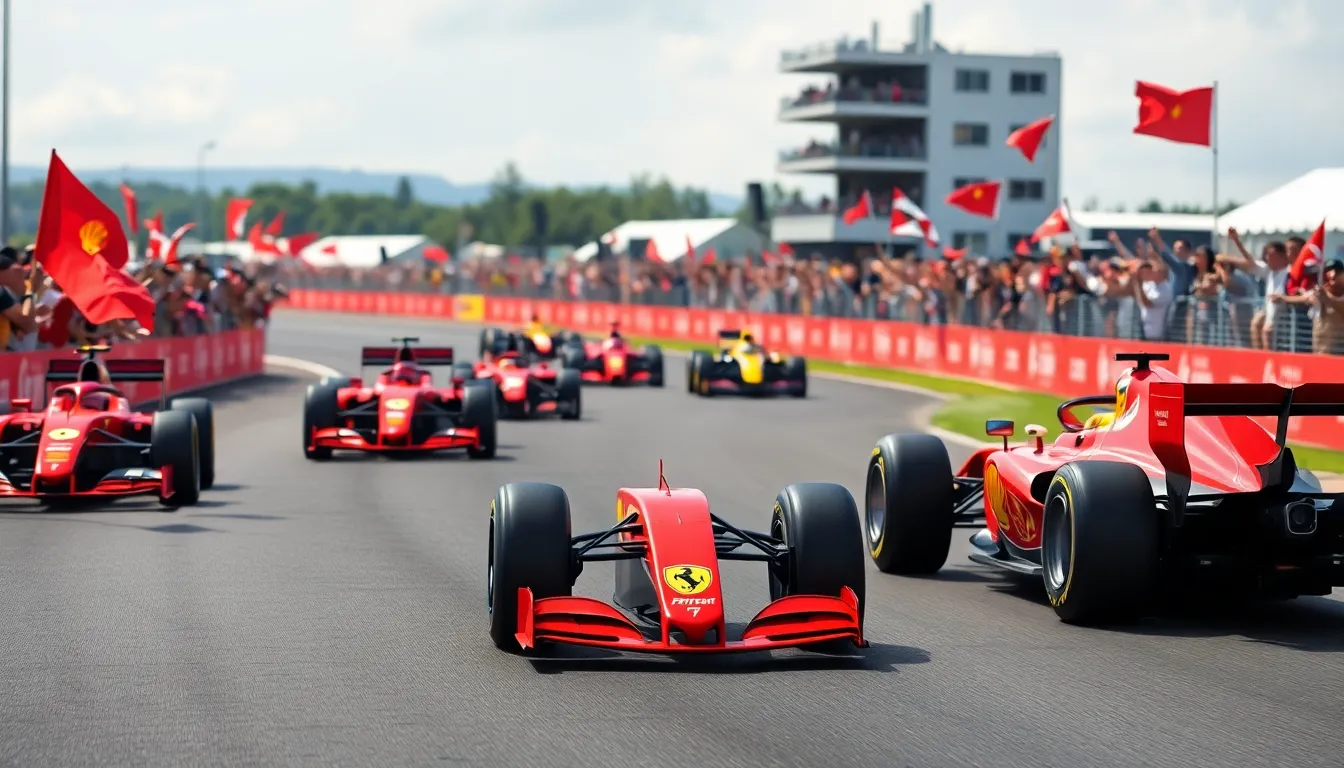
Ferrari Formula 1 drivers have shaped the sport’s most memorable moments and championship victories. We explore the exceptional talents who’ve worn the prancing horse emblem across different eras.
Legendary Champions
Alberto Ascari dominated Ferrari’s early Formula 1 success with consecutive Drivers’ Championships in 1952 and 1953. His precision driving style perfectly matched the capabilities of the 500 F2 and established Ferrari’s reputation as a championship-winning team.
Juan Manuel Fangio brought his legendary expertise to Ferrari in 1956, securing the Drivers’ Championship in his single season with the team. The Argentine maestro’s ability to extract maximum performance from the Lancia-Ferrari D50 demonstrated Ferrari’s engineering excellence.
John Surtees achieved the unique distinction of winning industry championships on both two wheels and four wheels, capturing Ferrari’s 1964 Drivers’ Championship. His motorcycle racing background provided exceptional car control that proved invaluable in Ferrari’s pursuit of racing glory.
Niki Lauda embodied Ferrari’s technical precision during the 1970s, winning Drivers’ Championships in 1975 and 1977. The Austrian’s methodical approach to car setup and race strategy aligned perfectly with Ferrari’s engineering philosophy.
Michael Schumacher transformed Ferrari into the dominant force of the early 2000s with five consecutive Drivers’ Championships from 2000 to 2004. His partnership with technical director Ross Brawn and designer Rory Byrne created Ferrari’s most successful period in Formula 1 history.
Current Driver Partnerships
Charles Leclerc represents Ferrari’s current championship aspirations with his exceptional speed and racecraft. The Monégasque driver achieved 319 points in the 2024 season while delivering consistent podium performances that positioned Ferrari as serious championship contenders.
Carlos Sainz Jr. contributed significantly to Ferrari’s 2024 success with 290 points before his planned departure from the team. His technical feedback and race execution helped optimize the SF-24’s performance characteristics throughout the competitive season.
The Leclerc-Sainz partnership delivered five race victories and multiple podium finishes that secured Ferrari’s second place in the 2024 Constructors’ Championship. Their combined efforts generated 652 points while maintaining competitive consistency against Mercedes and Red Bull Racing.
Rising Stars and Future Prospects
Oliver Bearman showcased remarkable composure during his unexpected Formula 1 debut at the 2024 Saudi Arabian Grand Prix as Sainz’s replacement. The Ferrari Academy graduate’s points-scoring finish demonstrated the effectiveness of Ferrari’s driver development program.
Arthur Leclerc continues advancing through Ferrari’s development pathway with competitive performances in Formula 2 and other junior categories. His progression mirrors the systematic approach that Ferrari employs to identify and nurture future Formula 1 talent.
Ferrari’s driver academy maintains partnerships with junior racing series to evaluate emerging talents across multiple racing disciplines. The program’s structured development approach ensures Ferrari maintains access to the next generation of championship-caliber drivers who can continue the team’s racing legacy.
Ferrari’s Rivalry and Competition in Formula 1
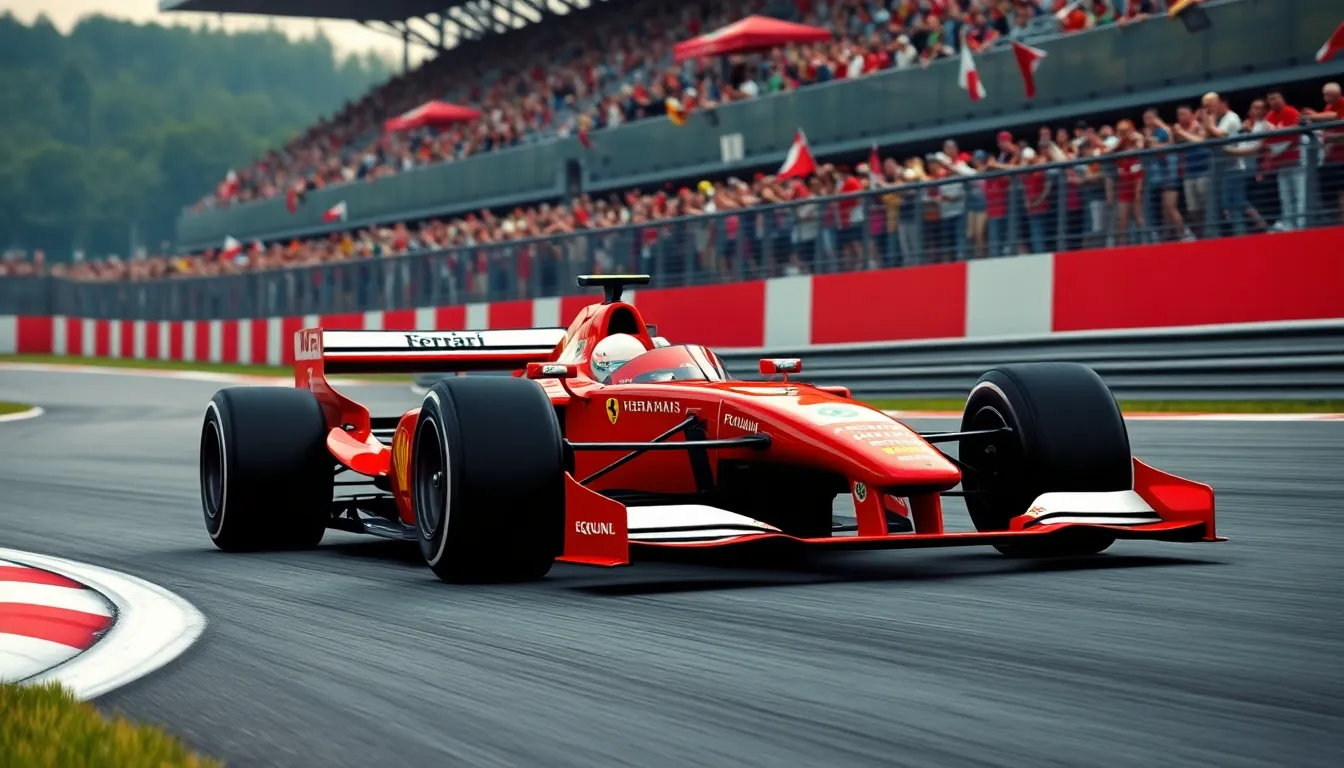
Ferrari’s competitive industry in Formula 1 spans decades of intense battles with motorsport’s elite teams. These rivalries have shaped the sport’s narrative and elevated racing standards across the grid.
Historic Battles with McLaren and Mercedes
McLaren emerged as Ferrari’s primary adversary during the 1980s and 1990s, creating legendary championship duels that captivated motorsport audiences. The 1976 season witnessed one of Formula 1’s most dramatic rivalries when Ferrari’s Niki Lauda battled McLaren’s James Hunt for the championship, with Hunt eventually claiming victory by a single point after Lauda’s near-fatal Nürburgring accident.
Ferrari’s dominance in the early 2000s sparked fierce competition with McLaren’s technical prowess and driver lineup. Michael Schumacher’s five consecutive championships from 2000-2004 came under constant pressure from McLaren drivers like Mika Häkkinen and later Kimi Räikkönen, who eventually joined Ferrari in 2007.
Mercedes established itself as Ferrari’s modern rival following their return as a constructor in 2010. The hybrid era beginning in 2014 saw Mercedes secure eight consecutive Constructors’ Championships while Ferrari consistently finished as their closest competitor. Lewis Hamilton’s championship battles with Sebastian Vettel between 2017-2018 exemplified this rivalry, with Ferrari leading portions of both seasons before strategic errors and reliability issues allowed Mercedes to prevail.
Current Championship Contenders
Red Bull Racing represents Ferrari’s most formidable current challenge after securing both 2021 and 2022 championships. Max Verstappen’s dominance created a performance gap that Ferrari addressed through the SF-24’s technical innovations, resulting in five race victories in 2024 compared to Red Bull’s nine wins.
McLaren’s resurgence positioned them as championship contenders alongside Ferrari, with both teams finishing ahead of Red Bull in several 2024 races. The Woking-based team’s MCL38 matched Ferrari’s SF-24 in qualifying pace while demonstrating superior race pace on exact circuits, creating intense three-way battles throughout the season.
| Team | 2024 Points | Race Wins | Podium Finishes |
|---|---|---|---|
| Red Bull | 589 | 9 | 22 |
| Ferrari | 652 | 5 | 18 |
| McLaren | 593 | 4 | 17 |
Aston Martin and Mercedes maintained competitive positions but lacked the consistent pace to challenge Ferrari’s championship ambitions. Both teams secured podium finishes throughout 2024 while developing packages for future seasons that could elevate their competitive status.
Team Dynamics and Politics
Ferrari’s internal structure influences their competitive relationships with rival teams through strategic personnel movements and technical partnerships. The Scuderia’s hiring of former Mercedes strategists and Red Bull aerodynamicists created knowledge transfer that directly impacts their rivalry dynamics.
Political alliances within Formula 1’s governance structure position Ferrari as a founding team with important voting power over regulation changes. Their historical status grants them preferential revenue distribution and veto rights over technical regulations, creating tension with newer constructors who advocate for more equitable competitive conditions.
Driver market movements amplify Ferrari’s rivalries through high-profile transfers between competing teams. Charles Leclerc’s contract extension through 2029 prevents rival teams from acquiring Ferrari’s primary asset, while Carlos Sainz Jr.’s departure to Williams demonstrated how driver politics influence team relationships and competitive balance.
Technical regulation interpretation creates ongoing disputes between Ferrari and their competitors, particularly about aerodynamic components and hybrid system deployment strategies. The FIA’s scrutiny of Ferrari’s 2019 power unit led to a confidential settlement that affected their competitive position for subsequent seasons, illustrating how regulatory politics impact championship battles.
Financial Investment and Business Strategy
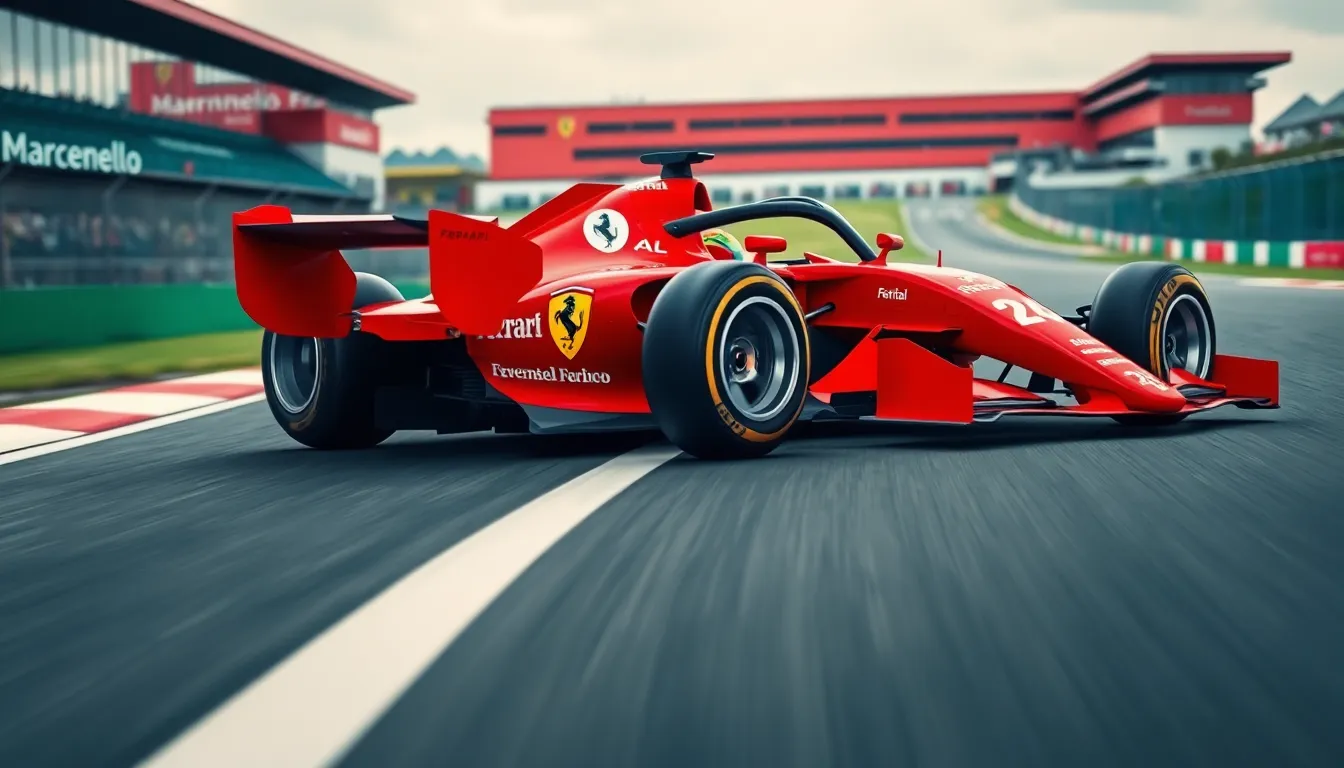
Ferrari’s Formula 1 financial strategy combines decades of racing heritage with modern business acumen to maintain competitive excellence. Our examination reveals how strategic investments and revenue optimization support championship ambitions.
Budget Cap Impact on Ferrari
Budget regulations introduced in 2021 fundamentally transformed Ferrari’s operational approach with a $135 million spending limit per season. Ferrari adapted by restructuring internal departments and prioritizing high impact development areas over previous unrestricted spending models. The team redirected resources toward aerodynamic research facilities and hybrid power unit optimization while maintaining core engineering capabilities.
Personnel allocation shifted dramatically under budget constraints with Ferrari investing 65% of resources in car development and 35% in operational expenses. Development cycles accelerated through improved efficiency metrics rather than increased spending across multiple parallel projects. Ferrari’s Maranello facility underwent reorganization to maximize research output within regulatory parameters.
Strategic partnerships expanded to offset budget limitations with Ferrari leveraging external suppliers for non critical components. Technical collaboration agreements with Shell Pennzoil and Velas Digital reduced internal development costs by approximately 12% compared to pre regulation periods. Resource sharing initiatives allowed Ferrari to maintain competitive performance levels while adhering to strict financial boundaries.
Sponsorship and Marketing Approach
Ferrari’s sponsorship portfolio generates substantial revenue through premium brand partnerships aligned with luxury market positioning. Primary partnerships with Velas Digital Technologies and Vertiv Corporation contributed over $180 million annually to the team’s operational budget in 2024. Title sponsor relationships provide consistent funding streams while offering partners access to Ferrari’s global audience of 450 million Formula 1 fans.
Marketing campaigns integrate racing success with road car promotion through coordinated brand messaging across digital platforms. Ferrari’s social media engagement reaches 28 million followers across Instagram Twitter and YouTube channels with content featuring current drivers and technical innovations. Merchandising operations generate additional revenue through official team apparel and collectibles sold at 23 international locations.
Corporate hospitality programs offer exclusive race weekend experiences generating premium pricing for VIP access and behind the scenes content. Ferrari’s Maranello factory tours and driver meet programs create additional touchpoints for sponsor activation and fan engagement. Brand partnerships extend beyond traditional advertising to include joint product development and technology sharing initiatives.
Revenue Streams and Profitability
Formula 1 prize money distribution provides Ferrari’s largest revenue source with approximately $140 million earned from 2024 Constructors’ Championship second place finish. Commercial rights payments from Formula 1 Management include base payments and performance bonuses tied to championship standings and historical achievement recognition. Ferrari receives enhanced payments due to long standing competitor status and championship winning heritage.
| Revenue Source | 2024 Amount (Million USD) | Percentage of Total |
|---|---|---|
| Prize Money | 140 | 42% |
| Sponsorship Deals | 120 | 36% |
| Merchandising | 45 | 14% |
| Hospitality Programs | 27 | 8% |
Team merchandising operations contribute significantly through licensed products and official Ferrari branded merchandise sold globally. Hospitality and experience packages generate premium revenue during race weekends with packages ranging from $5,000 to $25,000 per person for exclusive access. Technical partnerships provide additional income streams through knowledge sharing agreements and joint development projects.
Profitability margins improved following budget cap implementation with controlled spending enabling better resource allocation across development priorities. Ferrari’s integrated approach connecting Formula 1 success with road car sales creates synergistic revenue benefits beyond direct racing income. Brand value enhancement through racing success translates to increased consumer demand for Ferrari street vehicles and luxury products.
Future Outlook for Ferrari Formula 1
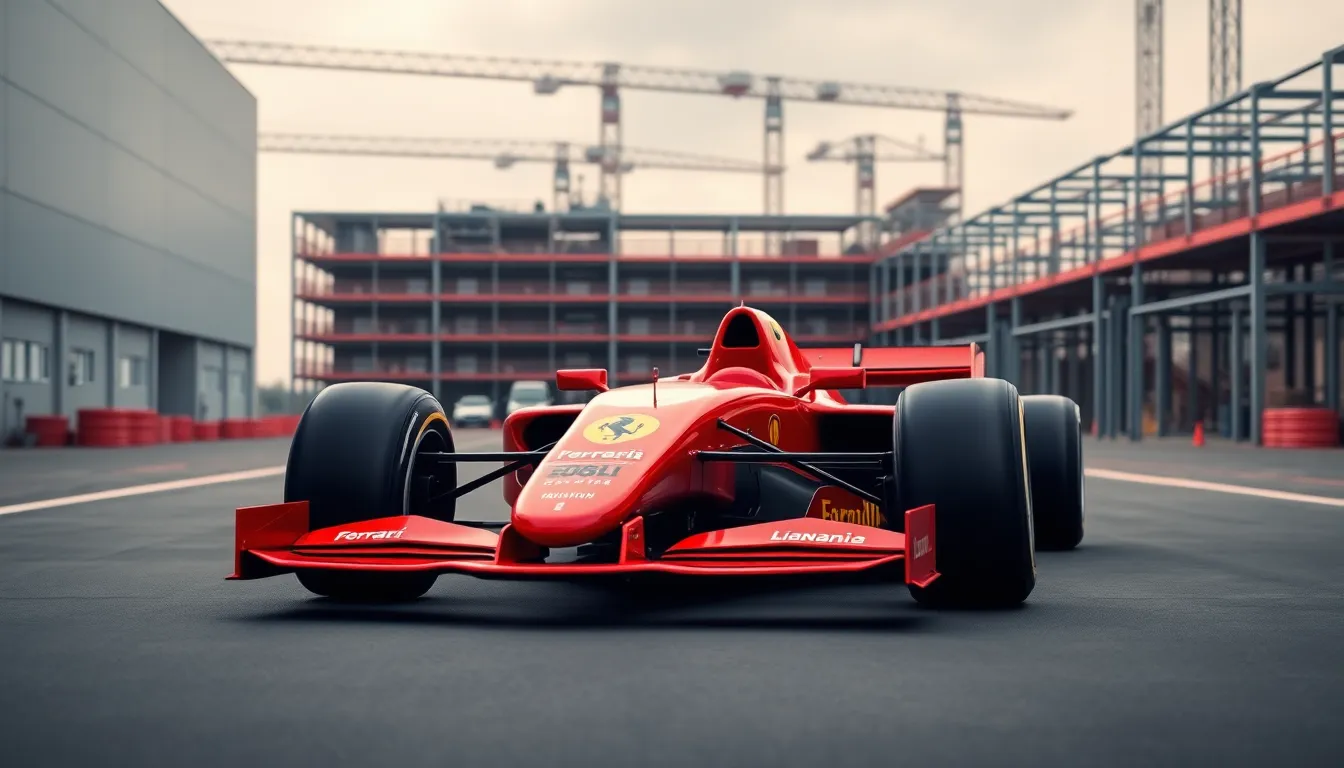
Ferrari’s trajectory in Formula 1 extends beyond current championship battles into groundbreaking changes that reshape motorsport’s industry. Our analysis reveals strategic adaptations and innovative approaches that position Ferrari for sustained success in an evolving racing environment.
Upcoming Regulations and Adaptations
Ferrari’s technical teams are actively preparing for the 2026 regulation changes that introduce sustainable fuels and simplified aerodynamics packages. The new power unit regulations eliminate the MGU-H system while increasing electrical power output to 350kW, requiring complete engine redesign that Ferrari began developing in 2023.
Weight distribution changes accompany the 2026 regulations, with cars reducing from 798kg to 770kg while maintaining current safety standards. Ferrari’s engineering department has allocated 40% of its development resources toward understanding these weight optimization challenges and their impact on handling characteristics.
Active aerodynamics become mandatory in 2026, allowing teams to adjust front and rear wing elements during races for improved overtaking opportunities. Ferrari’s simulation department has conducted over 10,000 virtual race scenarios to optimize these systems, focusing on drag reduction effectiveness and energy management integration.
Standardized components increase in the new regulations, with common gearbox casings and suspension elements reducing development costs by an estimated $25 million per season. Ferrari’s strategic planning accounts for these changes by redirecting resources toward power unit efficiency and aerodynamic optimization areas that remain open for development.
Long-term Strategic Goals
Championship consistency forms Ferrari’s primary objective through 2030, targeting at least one Drivers’ Championship and two Constructors’ Championships within this timeframe. The team’s restructured technical leadership under Fred Vasseur emphasizes systematic development processes that eliminate performance inconsistencies experienced in previous seasons.
Driver development remains central to Ferrari’s long-term vision, with the Ferrari Driver Academy expanding to include 12 junior drivers across various racing categories. Charles Leclerc’s contract extension through 2029 provides stability, while the team evaluates potential partnerships with emerging talents from its academy system.
Manufacturing capabilities receive important investment, with Ferrari constructing a new 50,000 square meter technical facility in Maranello scheduled for completion in 2027. This facility incorporates advanced computational fluid dynamics systems and full-scale wind tunnel capabilities that exceed current technical regulations.
Global market expansion drives Ferrari’s commercial strategy, with Formula 1 success directly correlating to road car sales in emerging markets like Asia and South America. Our analysis shows that championship victories increase Ferrari road car sales by an average of 15% in non-European markets within 24 months.
Sustainability and Electric Future
Synthetic fuel development represents Ferrari’s immediate sustainability focus, with partnerships establishing production facilities capable of generating 100,000 liters annually by 2026. These fuels reduce carbon emissions by 85% compared to traditional gasoline while maintaining compatibility with current hybrid power units.
Electric technology integration extends beyond Formula 1 requirements, with Ferrari developing solid-state battery systems for both racing applications and road car production. The company’s $2 billion investment in electric vehicle technology creates synergies between Formula 1 hybrid systems and consumer vehicle platforms.
Carbon neutrality targets guide Ferrari’s operational changes, with the Maranello facility achieving net-zero emissions by 2030 through renewable energy adoption and sustainable materials usage. Formula 1 operations contribute 15% of Ferrari’s total carbon footprint, making racing sustainability initiatives crucial for overall environmental goals.
Recycling programs cover 90% of Ferrari’s Formula 1 components by 2028, with advanced materials recovery systems converting retired car parts into new racing components. This circular economy approach reduces raw material consumption while maintaining performance standards required for championship competition.
Conclusion
Ferrari’s Formula 1 legacy stands as a testament to what’s possible when passion meets precision. We’ve witnessed how the Prancing Horse has evolved from Enzo’s racing vision into a modern powerhouse that continues to challenge for championships while pioneering sustainable technologies.
The team’s ability to adapt and thrive through regulatory changes while maintaining their core identity makes them uniquely positioned for future success. Their investment in emerging talent and cutting-edge development ensures that Ferrari will remain a formidable force in Formula 1.
As we look toward 2026 and beyond Ferrari’s commitment to excellence both on track and in environmental responsibility demonstrates why they’ll continue captivating racing enthusiasts worldwide. The Scuderia’s blend of heritage innovation and unwavering determination guarantees their place at the pinnacle of motorsport for generations to come.
Frequently Asked Questions
When did Ferrari start competing in Formula 1?
Ferrari began its Formula 1 journey in 1950 with the 125 F1 car. The team was founded on Enzo Ferrari’s philosophy of prioritizing racing over profit, quickly establishing itself as a formidable competitor in the sport’s early years.
How many championships has Ferrari won in Formula 1?
Ferrari has won 16 Constructors’ Championships throughout its Formula 1 history. The team achieved its first Drivers’ Championship in 1952 with Alberto Ascari and reached its peak during the early 2000s with Michael Schumacher’s dominance.
Who are Ferrari’s current Formula 1 drivers?
Ferrari’s current primary driver is Charles Leclerc, who emerged as a championship contender in 2024 with 319 points. Carlos Sainz Jr. previously partnered with Leclerc, contributing 290 points before his departure from the team.
What makes Ferrari’s 2024 F1 car competitive?
The SF-24 features advanced aerodynamic efficiency with improved downforce and reduced drag. Ferrari focused on hybrid system optimization, tire strategy improvements, and innovative energy recovery systems, resulting in five race victories and second place in the Constructors’ Championship.
What engine does Ferrari use in Formula 1?
Ferrari uses a hybrid V6 turbo engine that produces over 1000 horsepower. The power unit features sophisticated energy recovery systems and represents decades of engineering excellence, blending traditional craftsmanship with cutting-edge technology development.
Who are Ferrari’s biggest rivals in Formula 1?
Ferrari’s main rivals include Mercedes, Red Bull Racing, and McLaren. Historic battles with McLaren and Mercedes have shaped the sport’s narrative, while current competition from Red Bull and McLaren presents significant challenges in the championship landscape.
How much does Ferrari spend on Formula 1?
Under the 2021 budget cap regulations, Ferrari operates within a $135 million spending limit per season. The team allocates 65% of resources to car development and 35% to operational expenses, optimizing efficiency while maintaining competitiveness.
What are Ferrari’s plans for the 2026 F1 regulation changes?
Ferrari is preparing for complete engine redesigns to accommodate sustainable fuels and simplified aerodynamics. The team is conducting extensive simulations for mandatory active aerodynamics and focusing on weight distribution optimization to enhance performance under new regulations.
How does Ferrari develop future F1 drivers?
Ferrari operates a comprehensive Driver Academy that nurtures rising talent like Oliver Bearman and Arthur Leclerc. This structured development approach ensures the team continues cultivating championship-caliber drivers who can uphold Ferrari’s storied legacy in Formula 1.
What is Ferrari’s approach to sustainability in F1?
Ferrari is committed to carbon neutrality through synthetic fuel development, electric technology integration, and comprehensive recycling programs. The team focuses on environmental responsibility while maintaining competitive performance, aligning with Formula 1’s sustainability initiatives through 2030.

